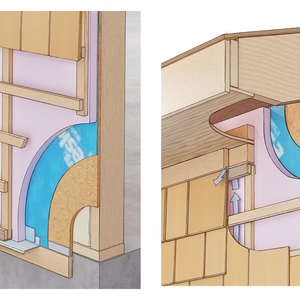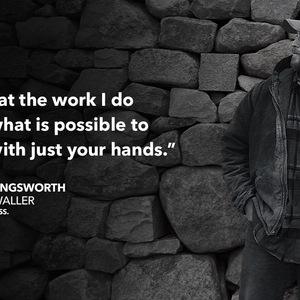I’ve got another Q for you guys.
One restoration project we are just finishing up has heart pine floors. The floor refinisher is finding them hard to work.
In the past we did find that heart pine has alot of pitch and resin in it that gums up the sanding paper quickly but this seems like the floor has been waxed multiple times and the wax is penetrating the wood too. He is afraid that the new finish might not stick very well.
Additionally, the designers and owners want to commit the greivous sin of painting these floors instead of using oil or poly. the designer also asked, “What about epoxy floor paint?”
So do you have any suggestions?
chemical strippers to cut the wax?
floor products to interact with it and stick good?
a place to buy cheap coffins for interior designers?
Excellence is its own reward!



















Replies
Ive done some of it but its not my expertise . Ive used chemical strippers and also amonia. Either works , one is cheaper and stinks, and the other is expensive with less results in my mind. I question why he is not using pads that can be washed out on a machine ? I would do most all of it with synthedic pads. At any rate I would have eliminated the wax completely before sanding. I agree that heart pine will render sanpaper useless.
A bad feeling moved over me when paint was mentioned . Thats a shame to paint a heart pine floor . It would be a good base for an oak selrct floor however which would solve the finishers problem. I would try the above before I aborted the mission . I can understand if he doesnt want to warrant it . Epoxy will work great as I have used it on shop floors and automotive stores. It would also have to be free of wax though , and that would mean taking the floor down a 1/16 or so because the wax will be in the grain as you know. Usually wax is removed from the surface just for another coat of wax rendering wax in the pores incidental. I have refinished a lot of cabinets and furniture and always have to remove greases ands wax before I have any success. Wax has always been hard to deal with as I just got done with multiple peices of oak furniture . It was stripped and sanded to bare wood and I got and inferior finish. I washed with straight amonia and solved the problem, even after stripping . Autobody has problems with wax too. They prefer polish . Wax is bad stuff..
Tim Mooney
If you're lucky, Ditch will be along to give you his advice. Until then, or in lieu of it, I'll give you mine based on experience…….. for what it's worth.
I've refinished a few floors that sported a penetrating oil finish and numerous coats of wax over the years. I simply cleaned them well with mineral spirits a couple of times in advance of sanding to remove the paste wax and had no problems with finish adhesion which was oil-based poly. If you're unconvinced that this would remove all of the wax residue, you could always do an additional wipe down with lacquer thinner.
The problem I see of sanding prior to removing the wax is that it could heat up under the sandpaper, become liquid and penetrate even further down into the wood making it more difficult to remove. Since the heart pine has so much pitch, it clogs the paper which then has the opportunity to heat up that wax rather than remove it readily and that's where the problem would be, I think. Anyway, I've always avoided finding out in the past by removing the wax first.
The kitchen here is old growth heart pine and yes, it clogs sandpaper. It's not near as fun to sand as other species because of that, but there's not much you're going to do about that part.
Years ago, I stripped the finish from several large rooms of hard maple flooring with ammonia. Much cheaper than strippers, but you best get a lot of forced ventilation going or you're going to fry your brain, damage your eyes and your lungs if you aren't wearing an appropriate respirator. And in addition I'd say this………….if you think you might decide to use ammonia …….test it out in an inconspicuous area first. I've watched it dissolve the pitch in fir and some species of pine. The result is wood that literally comes apart and turns into a big furry stick of unusable material.
Why in God's name would anyone go thru all that work/expense and then paint heart-pine? I fear because they saw something in a mag that tickled the "gotta have that look" hair.
Thanks for the warning on the ammonia. I went down to that job tonight and we tried it in a few small test spots. My impression is that it didn't do more than clean the wood a little.
We are palnning to try screening and rubing with lacquer thinner and then a test spot to see if it bonds OK for a week. The screeing won't heat up as much and we don't need to remove every single nick and scratch with a deep sanding since it will be UGH painted. ( I fought all winter with the interior designers on the painting but they and the owners both are set on a certain "look" for the whole room. The funny thing on the decorators is that the library has plain white pine slab floors and they want to keep it as is with just a cleanup and polish. It looks like a barn floor to me but they find it to be "inspiring"! I know when I'm beat but other customers will pay an arm and a leg to have the floor in the living room that will be painted over. Maybe I'll get lucky and the wax will release it in a couple of years about the same time that they start to think that they should have kept it oiled. LOL
The playroom and kitchen have hard maple floors and the wax doesn't go deep on it. A quicky with 60 grit will bring us to wood.
My instinct on this is that we will be OK this way but we're proceeding cautiously. .
Excellence is its own reward!
piffin
I know now to solve both the problem with the floor and the decorator and make some extra money as a side benifit.
Take out the floor and then replace it with osb. As it is being painted they won't care.
Then with old floor you can either run it through a planner to get past the wax or install it upside down. In either case you will be installing it one of your other clients that will pay an arm and a leg for it.
BTW, I wonder how shellac would work as a barrier coat. You might want to ask Jeff Jewitt over at his forum, homesteadfinishing.com
Also I ran into a forum someplace that is just on floor finishing. You might try a google on FLOOR FINSIHING FORUM.
I don't think the designers deserve coffins in this case.
I assume the idea of not painting the floors has been brought up already with the owners in the sabsence of the designer. Would there be any issues in the future with having your name attached to "the painted floors?" I sometimes think designers feel compelled to do extreme renovations just so they can justify their existence. In most cases, simply restoring an older house to its original design is the best thing to do, and doing that doesn't really require a designer. When we were looking at houses a couple of years ago, we saw a number which had pretty much been destroyed by people "making statements." It might be a good idea to mention it to the owners that a sanding and painting of the floor would likely mean that it could never be returned to its natural state, hence they would be losing alot of value in their house. Perhaps they are mistakenly holding onto the notion that doing this won't devalue the house.
Believe me, I've laid it all out for them, pros and cons..
Excellence is its own reward!
"Believe me, I've laid it all out for them, pros and cons"
I knew that with out you saying. I have a clear picture of it in my head.
Tim Mooney
Try Naptha as the de-waxing solvent. It is slower than lacquer thinner and is used in many wax products. Naptha is the primary solvent in lighter fluid, and is much cheaper than lacquer thinner. I n either case, use lots of ventilation, and watch thiers eyes. When they start to dilate, get them out of there, no matter how good the respirators. send the designer in :-)
Hey Pif,
Just sand over kerosene. Wring the rag out till it's almost dry, then rub down half the room, sand away. Keeps the paper open and breaks down whatever is on the floor....been doin it for years....old bowling alley trick. Seal with 2 coats OMU sanding sealer and 2 top coats of your choice of finish.
Open the windows, kick somebody's a$$ if they light up a smoke.
Ditch